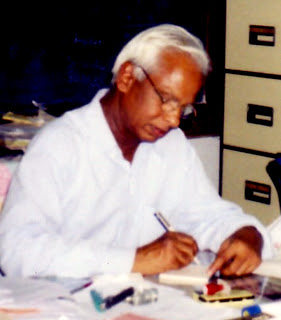Daalmaa (henceforth “dalma”), presumably yet another typical Odia
dish, is essentially yellow dal – moong or arhar - mixed with plenty of
vegetables, preferably of the local variety. One could choose at least two or
three from a set: brinjal, radish, raw banana, gourd, arbi, potato, beans of
all kinds, jack fruit, jack fruit seed, and tomato, among others. One might
think it’s like sambar, but it is not; with a lot of vegetables it is thick,
and it’s not sour at all, and to make it tastier, there are things that can be
added to it like coconut, jeera powder and kali mirch (pepper) seed or powder
and some other spices as well, which is not the case with sambar. An
incorrigible non-vegetarian would put some deep-fried prawns in dalma for taste
or aroma. In certain ways, it’s a quite
useful dish, although some would prefer to view it as a deprivation dish: if
there aren’t enough vegetables or enough dal to cook separate dishes, dalma is
the solution. This apart, one cannot make just dal, there has to be a vegetable
dish to go with it, but preparing a vegetable dish needs attention and takes
time; so if one is in a hurry, then dalma is the best option. For the same
reason it can be a distress dish as well, when guests arrive all of a sudden
and unannounced at that, and there is neither enough vegetables at home nor
enough time with the hostess to cook separate dishes of dal and vegetables for
the guests. It’s thus a problem solver; therefore its increasing popularity
among the urban lower- and middle- middle class is no surprise. At a feast, especially
a traditional one, what is served is dal, not dalma.
Dalma until recently was a
Puri-based dish, where people for some reason (having to do with the dampness
of the climate, one is told) chose to eat roti and dalma for dinner. Surely the
main choice was between rice and roti, and once roti was chosen, dalma had to
be the natural choice, because of its thickness. There are eateries in the town,
which specialize in dalma making, and these have a roaring business selling
roti and dalma at night. The people of Puri have explored the delights of
eating dalma in a variety of combinations – with sweet and salted cakes, puri,
sweet powdered beaten rice, called chudaghasa, etc. With roti made of boiled
atta (wheat flour), called khali roti. Khali roti and dalma constitute a
speciality; it is offered to Lord Hanuman in one particular Hanuman temple –
Siddha Hanuman - on the outskirts of this temple town as a special offering.
Now gods must have whatever their devotees relish. However, khali roti is not
normal food in Puri, and outside of Puri, khali roti is sick food, rarely
eaten, even as such.
It is only during the last two or
three decades that dalma has become a pan-Odia dish. However outside of Puri,
it is still a “marked” or special dish, using a jargon from modern linguistics;
the “unmarked” or normal one is dal. More recently, the establishment of a
chain of excellent, affordable eateries, called Dalma, in several cities in
Odisha has given dalma a brand name. These popular restaurants offer a range of
delicacies, both vegetarian and non-vegetarian, but do not specialize in dalma.
People in fact do not go there to eat quality dalma. For the tastiest dalma one
still has to go to Puri, to some of the modest roadside dhabas in the narrow
lanes of this temple town.

No comments:
Post a Comment